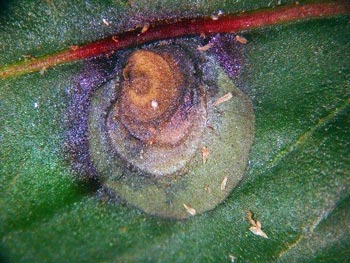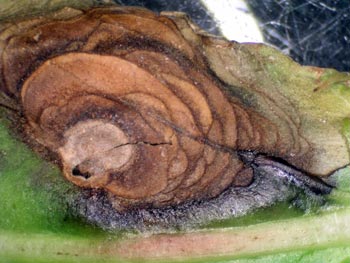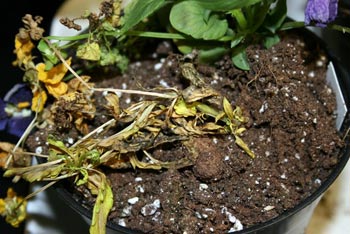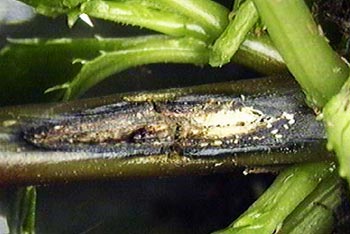Myrothecium: A stem, crown and leaf spot disease of floriculture crops
Myrothecium roridum is a pathogen of bedding plants and perennials that causes a crown and stem rot or even a leaf spot. Symptom identification and control strategies are key to management.
Myrothecium roridum is a pathogen that periodically causes crown and stem rot on pansies and leaf spot on New Guinea impatiens. It can also cause disease symptoms on begonias, lantanas, petunias and verbenas. A number of herbaceous perennials like bugleweed, coneflower, larkspur and purple coneflower can be hosts as well.
Leaf spot symptoms cause concentric rings or target spots on the leaf lesions (Photos 1-2). Raised, black structures will develop on the infected tissue under high humidity. They can be covered with a white tuft of growth as well. They are call sporodochia.


Photos 1-2. Myrothecium lesion on leaf. Photo credits: (Left photo) Jan Byrne, MSU, (Right photo) Bruce Watt, University of Maine
According to Michigan State University Extension, crown rot symptoms start as a brown soft rot (Photos 3-4) in the crown and on adjacent leaf petioles. This later causes a rapid collapse of the entire plant. Within the infected tissues, tiny white and black spore sporodochia can be found. These spore masses serve as a mechanism to spread the disease when hand-watering or automatic irrigation is used. Some researchers indicate that wounding on the stem from mechanical transplant machines or even hand-transplanting can cause an increase in disease susceptibility and frequency. This injured tissue becomes an entry point through which the pathogen can infect the plant. Also, increased fertilization rates cause lush foliage that can lead to more outbreaks of Myrothecium.


Photos 3-4. (Left) Pansy infected with Myrothecium rot. (Right) Stem infection close-up. Photo credits: (Left photo) Jan Byrne, MSU, (Right photo) Bruce Watt, University of Maine
If you suspect an outbreak of this disease, be sure you send samples to MSU Diagnostic Services for positive identification. Crown rot symptoms can mimic Rhizoctonia; however, the fungicide recommendations for Myrothecium are different.
If you have an outbreak of this disease, dispose of all infected plants, growing media and cell packs or pots. Be sure to clean and then disinfect all benches and ground mats where these plants were placed before reusing them for another crop. As with most diseases, avoid irrigation schedules that leave the plants wet for extended periods of time.
When this disease has been identified in the facility, the following protective fungicides can be used based on MSU research conducted by Mary Hausbeck:
- Medallion (fludioxonil)
- Daconil (chlorothabnil)
- Terraguard (triflumizole)
- Cleary’s 3336/OHP 6672 (thiophanate-methyl)
Follow all label directions and requirements. For further information, contact your local MSU Extension greenhouse educator.



 Print
Print Email
Email

